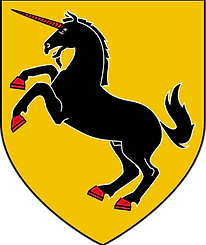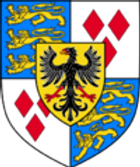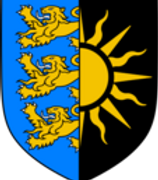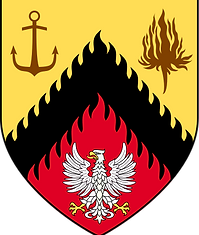
Kingdoms
Characters in the Northern Kingdoms come from somewhere, this could be the Kingdoms of their birth or simply the Kingdom where they have spent most of their lives.
Selecting a Kingdom is important, not only does is give your character certain perks but also gives your character a national identity with plenty of options to develop your character, interact with others from your nation and further the goals and plot for that nation.
Redania
The Kingdom of Redainia is nestled in between the Buina and Pontar rivers and can trace its dynasty back to the first landing of humans on the banks of the Yaruga.
Redainia is a highly ambitious nation and has never ceased to remind is neighbours of its lofty goals.
Tretogor is Redainia's capital yet is true pride and joy is Oxenfurt and its university there.
Redainia's army is the largest of the Northern Kingdoms with its famed Royal Corps having fought valiantly in the previous two wars with Nilfgaard.


Kaedwen
To the east of Redainia is the wooded realm of Kaedwen. It is the youngest of the Northern Kingdoms having only taken its current shape since the second war with the elves two centuries ago. For this reason the distain the Kaedweni feel for that race is still quite fresh and the feeling is mutual.
Kaedwen also has frequent clashes with its neighbours, none more so than with Aedern to the south.
It's capital is Ard Carraigh but it's most famous city is Ban Ard and its sorcerers school there.
Due to Kaedwen's quarrelsome nature and history with conflict, and its wooded area, the other kingdoms view them as troublesome provincials, no better than the descendants of brigands and outlaws.
Temeria
The northern border of Temeria is delineated by the pontar, to the west the realm borders the seaside Cindaris. To the East, by means of the Mahakam massif itself, the realm boarders kaedwen, Aedirn and Lyria.
For a long time the Yaruga formed its southern border, apart from its borders with Brugge and Sodden. But during its long history Temeria came to rule the lands south of the Yaruga.
That history, much like Redania’s, dates back to the first landing. Both kingdoms share a storied history of neighbourly rivalry, border disputes, and local wars.
The Tamerian kings hold court in Vizima, located on the shores of a beautiful lake. The realm’s other important cities include Maribor, heavily fortified Mayena, and the bustling port city of Gors Velen, famous for its proximity to the famous sorceresses’ school at Aretuza.
Before the onset of the crisis which now plagues that realm, Temeria was one of the most powerful of the Northern Kingdoms, and its cruelly assassinated King Foltest also held the titles of Duke of Sodden, Sovereign of the Pontar and Mahakam, and senior protector of Ellander, Brugge, Riverdell and Angren.
.


Aedirn
Much like its neighbour Kaedwen; Aedrin formed later than its western neighbours. Despite this Aedirn has developed faster than Kaedwen to the north, a fact that most Kaedweni deeply envy.
Aedirn enjoys is prosperity due to its fertile lands and mineral wealth in the mountains to the east. The cities of Gulet and Eysenlaan are huge centres of metallurgy, Aldersburg and the nation’s capital Vengerburg house huge textile workshops, dye works and distilleries.
Aedirn has suffered greatly during the last two years, as a result of boarder disputes with Kaedwen and the resulting war over its northern provinces, and he recent second war with Nilfgaard. The empire not only plundered and burned, but also disassembled entire production centres and shipped the machinery South.
Moreover, the peace accords forced Aedirn to give up a portion of its territory, the valley of flowers, to the elves.
Stories coming out of Aedirn after King Demavends death speak of civil unrest, peasant revolts and another conflict with Kaedwen, and a growing separatist movement in the Pontar valley.
Skellige
The rocky, inhospitable Skellige Archipelago is one of the earliest lands settled by humans. Its people are valiant and skilled sailors – merchants, as well as robbers and pirates – who in addition to the common tongue also speak a native dialect of the Elder Speech. Also in contrast to the continental north, the Skellige islanders are predominantly freemen, possessing right nearly equal to those jarls who lead them.
The islanders are united under a king chosen from one of the major clans, who is elected during traditional moots. His subordinate jarl is the commander of the military, leading, among others, the marine kingdom’s powerful fleets. The Skellige Islanders are long-time allies of the Kingdom of Cintra, having been connected to it through marriage – the king of Cintra, Eist Tuirseach, was also the brother of Skellige’s King Bran and the uncle of Jarl Crach an Craite. After King Eist’s death in the battle of Marnadal Dale, the islanders swore bloody vengeance on the Nilfgaardians, becoming their implacable foes.
Cidaris
Though is territory is much smaller, Cidaris’s history of as long and rich as those of Temeria and Redania. This small, beautiful realm owes its wealth and prosperity to marine trade and rational exploitation of the ocean’s wealth through fishing, pearl hunting and amber mining as well as its famous vineyards. Goods from all the four corners of the world can be found at the famous sea bazaar of Cidaris and the city’s ship yards launch and overhaul several hundred ships per year.
King Ethain of Cidaris is widely considered an enlightened, just ruler, as well as a wise politician who does not meddle in its neighbour’s affairs and expects the same in return.
The last war against Nilfgaard was the exception as Cidaris supported the northern coalition with its fleet.


Lyria & Rivia
This small kingdom has been Aedirn’s staunchest ally for quite some time, forming the bulwark against the threat of Nilfgaard and defending the stragegic boarder formed by the Yaruga river. Lyria contains one of the only two locations suitable for mass crossings of the great river, in the region known as Dol Angra. This crossing was defended by the Lyrian built fortresses of Spalla and Scalla.
Queen Meve ruled this kingdom although it is not known if she still lives since the start of the third war against Nilfgaard. During recent conflicts with Nilfgaard she came to be known as a strong, resourceful woman almost second to Calanthe. Indeed, the monarch commonly reffered to as “the white queen” or, less official “the virile widow” personally organised a resistance movement against the imperial occupation. Leading a motley force culled from knights, peasants and common bandits, she harassed and ambushed Nilfgaardian troop without rest or mercy, winning the undying love and admiration of her subjects. It is said that they would willingly ride through hellfire if the queen so commanded.


Cintra
Cintra was the first northern kingdom to fall before the advance of the Nilfgaardian empire; rather than suffer indignity in defeat its queen, Calanthe “the lioness of Cintra” threw herself from the walls of her palace. Her husband Eist Tuirseach fell in the battle of the Marnadal Pass, his brother King Bran of Skellige and uncle, Jarl Crah an Craite later swore their bloody vengeance against the Nilfgaardian Empire.
The proud Cintrian people now little more than refugees banded together and were instrumental in the defeat of the empire at the battle of Soden hill. Ever since the first war Cintra has been occupied by the Nilfgaardian Empire, its people scattered and dejected; and yet they still fight on in the hope of liberating their homeland and returning their true queen to the throne, Cirilla Fiona Elen Rhiannon “the lion cub of Cintra”.
Verden
Verden was at one time a vassal of the kingdom of Cintra, which is now occupied by the Nilfgaardian Empire. It hold a strategic location at the mouth of the Yaruga and its three fortresses of Nastrog, Rozrog and Bodrog command the rivers northern shore. During the last war against Nilfgaard, Verden betrayed its former allies, paying homage to the empire and assaulting its neighbour, Brugge.
Prince Kistrin then led a successful rebellion against his treacherous father bringing Verden back into the Northern coalition. Despite this return to the northern fold or perhaps in part because how quickly it followed Verden’s first defection, the young king Kistren and Verden as a whole continue to be viewed with suspicion by their neighbors.
Rumours of Verden’s collusion with Nilfgaard have spread throughout the north in recent months, due to the speed of Nilfgaard’s advance north given Verden’s strong defensive fortifications along its side of the Yaruga. King Kistren has not been seen since the invasion to deny these rumours which have only served to strengthen their validity.


Brugge
Venzlav, the king of Brugge, was also a vassal of Cintra but after the fall of its neighbour he turned to Temeria for protection, paying homage to his cousin, King Foltest. This was hardly surprising as on a sunny day he could plainly see the flashes of Nilfgaardian spear heads across the Yaruga.
Though Brugge was a small and poor kingdom, its people fought with unforeseen valour during the last war against the empire, both went defending their lands against Verdenian volunteers and the professional Nilfgaardian army and during the later clashes which led the victory at Brenna.
The Free City of Novigrad
If any city in the North deserves the lofty title of Capital of the world, it is definitely Novigrad. Perched on the mouth of the Pontar like a fat merchant in an inns alcove, it is surrounded by the similarly familiar smell of sweat and money. Like our archetypal merchant is loud, foppish, covetous of profit above all else, and allows no one to disregard it. That is because the Free City of Novigrad is undoubtedly the greatest port on the great sea, and over a dozen of the most influential merchant companies make it their home. It also boasts four huge water mills, eight banks, nineteen pawn shops, almost forty inns, a dozen whorehouses and nearly two dozen temples, most dedicated to the eternal fire. Recently, that cult’s influence has reportedly grown considerably, allowing it to begin to wield real power among the city’s faithful. This is somewhat surprising, since the hierarch, Cyrus Engelkind Hemmelfart, though known for his racism, is an old, slothful geezer who doesn’t care for oppressing nonhumans nearly as much as he cares for arriving at the privy in time. Perhaps the new steward of state security, who replaced his predecessor by burning him at the stake after a public trial, is the one truly responsible for this state of affairs.


Dol Blathanna
In Elder Speech, the name of this realm means Valley of the Flowers. Dol Blathanna was once part of the kingdom of Aedirn, but lies on territories seized from elven hands two centuries ago. Ther return of this territory to provide space for an independent elven realm was one of the conditions of the peace accords signed by Nilfgaard and the Northern kingdoms after the second war. This new freedom came at a steep cost, purchased with the lives of hundreds of elves from the Scoia’tael units who fought and died on the side of the empire.
The same peace treaty that created the Valley of the Flowers had another bitter and contentious condition, as Nilfgaard agreed to hand over roughly three dozen elven officers accused of war crimes to the Northern kings. No wonder then that many elves now feel they have been betrayed and used by Emhyr.
Although the humans who left Dol Blathanna burned and destroyed everything they could, intending to leave only a “Valley of Ashes” for the Elves, the Aen Seidhe hope to rapidly rebuild and have sworn to defend their new home land with their very lives.
Mahakham
The origins of the dwarves date back to ancient times, even predating the conjunction of spheres. They are a short, but stout and tough, people accustomed to hard work. They have a reputation for being honourable and dependable, but are also often seen as endlessly grumbling curmudgeons caring little but for their kin and gold, which they invariably love to accumulate. In this, it is often said they are second only to dragons and men. They are also famous for the great jealously with which they guard their less than handsome women, believing that everyone else awaits the chance to seduce them. Very few have deigned to risk explaining to a dwarf why the belief might be erroneous.
The dwarves ancestral homeland is the mountainous region of Mahakam, though many also live in human cities plying their various trades as craftsmen, bankers or merchants or find work as mercenaries or bodyguards.
